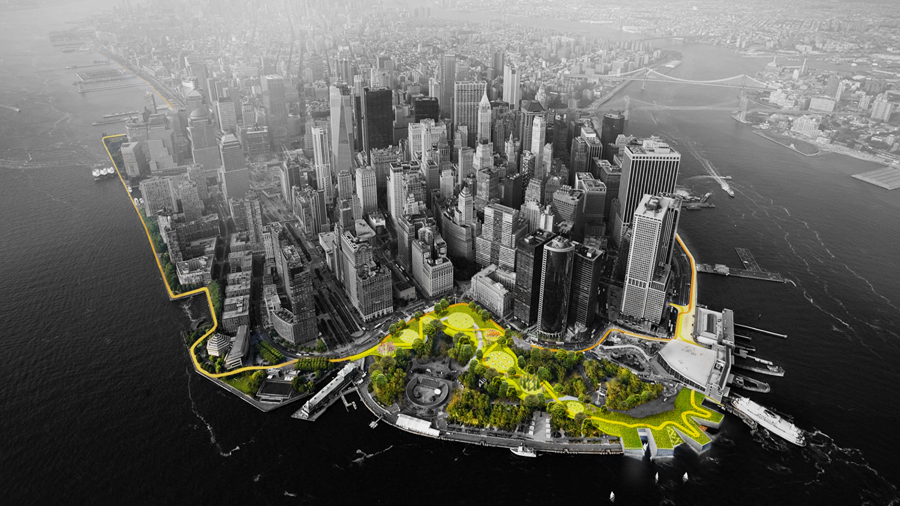But how will we fund urban resilience measures when governments are strapped for cash and individual businesses struggle to invest in solutions to broad risks?
This is a global challenge.
A team driving innovative 'Resilience Bonds' based in NYC asserts: The pipeline of projects remains stubbornly stuck in traditional,direct revenue models, such as toll roads and bridges, and planning for resilience upgrades and improvements remains a public sector challenge.

Download this report funded by Rockefeller Foundation
"New collaborative models are needed to tackle challenges like this one."
Since 2014, 16 companies from infrastructure, finance, property and other service sectors have joined the Business Adaptation Network (BAN) alongside research and local government members to share challenges and advance climate adaptation practices across Australia.

This group has brought diverse insights and capabilities to the table.
I facilitated a recent Sydney gathering of 50 business and local government leaders who gathered at ANZ Bank to consider these key questions:
• What needs funding?
• How do we fund projects?
• Are there standards we can use? Do we need more?
WHAT NEEDS FUNDING?
"City of Sydney Chief Resilience Officer Beck Dawson asked what it will take for metropolitan Sydney
to build shock absorbers in advance of escalating heat wave, bushfire, severe storm
and flood risks. She guided workshop participants towards c0-created responses."
• Start local
Top of the list: street-level, socially driven social investments like planting up streets, painting bike lanes and investing in neighborhood clean-ups. When natural disasters hit, the cost to ecosystems, community, business and government is reduced if our cities are more mobile, our urban canopy can cool us down, and our waterways are not clogged with waste.

Post flood waste image, Newcastle Herald
• Adaptive infrastructure
The cost of under-grounding electricity cables to mitigate bushfire losses seems prohibitively expensive - until you compare it to recurring peri-urban bushfires and escalating loss scenario as cities boundaries reach closer to surrounding catchments. Our pricing rules prevent under-grounding cables but in the US novel environmental upgrade agreements are enabling investment in adaptive infrastructure.
• Integrated responses
Our cities are getting hotter. According to a widely cited University of California study of 217 cities globally, nearly half the cities experienced an increase in heatwaves between 1973 and 2012 while just 2 per cent experienced fewer. Others suggest cities are warming at a rate up to 30 per cent higher than the surrounding, non-urban environment.
They will not be livable unless we copy Singapore by aggressively investing in the urban canopy. This will mitigate urban heat islands, provide community refuge and support business continuity through heat waves and floods at street level.
 Singapore's Alexandra Arch & Forest Walk by LOOK
Architects.
Singapore's Alexandra Arch & Forest Walk by LOOK
Architects.
Heat-wave responses can be educational and socially engaging if packaged to include community based white-roof programs, solar investments, battery storage and tree planting.
Just as local conversations about future-proofing can create incentives for product development, big data can further enable public participation by helping residents and local governments to visualise how their investments are weaving a neighbourhood scale resilience fabric.
• Inviting governments and citizens to lead
Singapore's top down leadership has delivered world-class sustainability responses that test the capacity of Western Democracies to respond to climate change.
Australians expect our governments to make big, tough investment decisions, yet our governments do not appreciate the scale of the livability challenge nor the costs of failing to adapt.
We need a communications campaign that engages all levels of government and we need to unleash the power of deliberative democracy to enable prioritisation of resilient infrastructure investments.
 Victorian government empowers citizens to inform
infrastructure spend
Victorian government empowers citizens to inform
infrastructure spend
Citizen's Juries become immersed in knowledge about current and emerging risks and benefits arising from different investment choices. They are well placed to lift their gaze beyond short-term political cycles, if governments entrust them with informing infrastructure investment decisions.
HOW DO WE FUND PROJECTS?
"ANZ's Cath Bremner believes resilience funding is a potential solution.
Major investments can be repaid through small rate increases over many years with this view."
Options include:
• Supporting metro Sydney local governments to leverage 'fit-for-the-future' funding towards resilience investments.
• Providing resilience-retrofitting incentives for homes and commercial buildings to drive down insurance premiums and mitigate disaster response costs.
• Implementing environmental levies to fund project finance.
• Developing new debt instruments: Infrastructure Resilience Bonds (IRBs) that draw on funds collected through levies from those that benefit from the infrastructure.
• Exploring Social Impact Bond (SIBs) to fund the community sector to protect the vulnerable from heat waves.

Review resilience funding options canvassed recently byBAN members
supporting Queensland Climate Adaptation Strategy development
WHAT GAPS EXIST IN CURRENT BOND STANDARDS?
"According to EY's Graham Sinden, new debt-instrument standards
will need to be developed and existing bond standards must evolve if
we are to capture the far-reaching benefits of projects aiming to enhance resilience."
Gaps in bond standards include:
• The capacity to give certainty in outcomes and benefits.
• The establishment of metrics for performance.
• The identification of counterparties. Who will pay out the bond plus realisation at the end of the period?
• How do we accrue value? Who collects the benefit of the projects? How are costs and benefits allocated?
• Benefits will be highly distributed in nature and over a medium term (~25 years). Long-term nature of projects may be a requirement and contribute to making a project investment grade.
• How do communities provide input, and drive prioritisation on projects. How do projects demonstrate community buy-in, support and benefit?
Where to from here?
Ideas from this workshop will be progressed by the Resilient Sydney project, with BAN member participation.
Learn more about BAN here, Resilient Sydney here, and BAN workshop host ANZ's view on climate bonds here.
BAN is a member-funded community of practice. Join us by contacting Directors of the Board of Green Cross Australia Adam Davis (Adam.Davis@aecom.com) or Sarah Kinsela (Sarah.Kinsela@lendlease.com).
Article by Mara Bun, a Resilience Consultant to Green Cross Australia. Mara is a Non-Executive Director and moderates gatherings with purpose.
This article is co-published in ANZBlueNotes: https://bluenotes.anz.com/posts/2016/04/funding-a-sustainable-future-debt-but-not-as-we-know-it/


